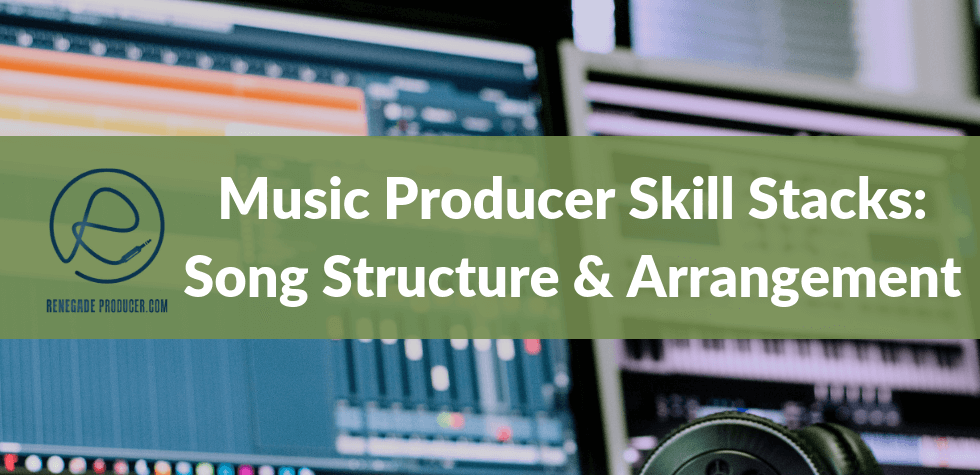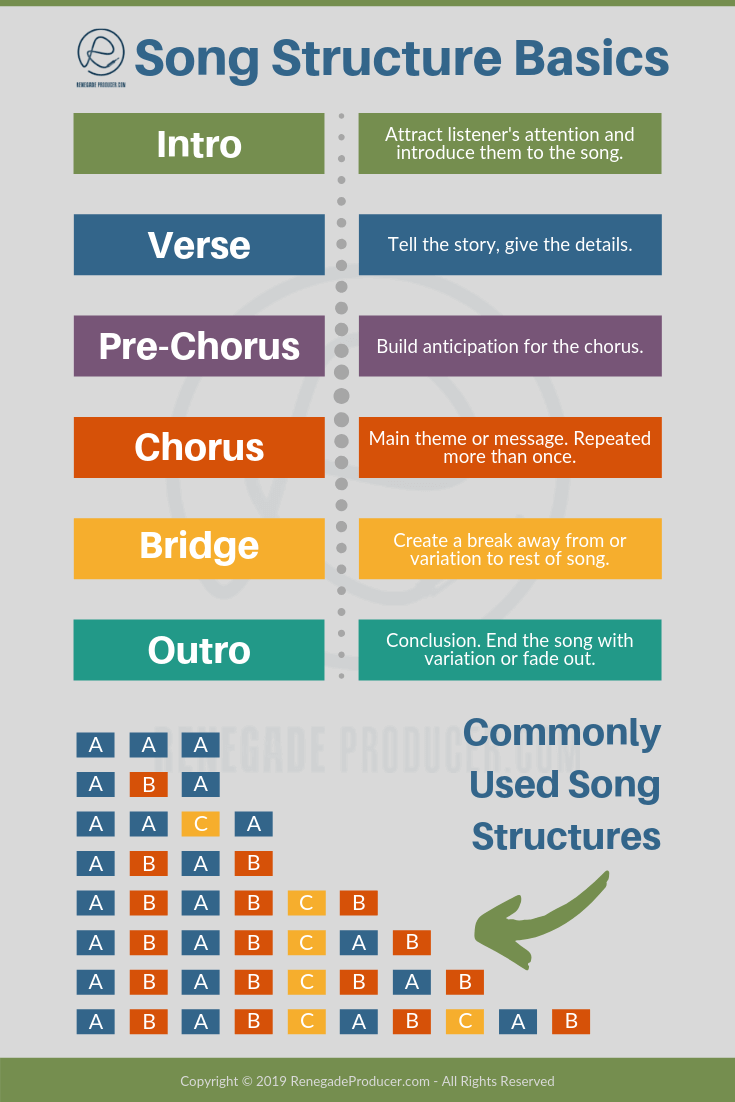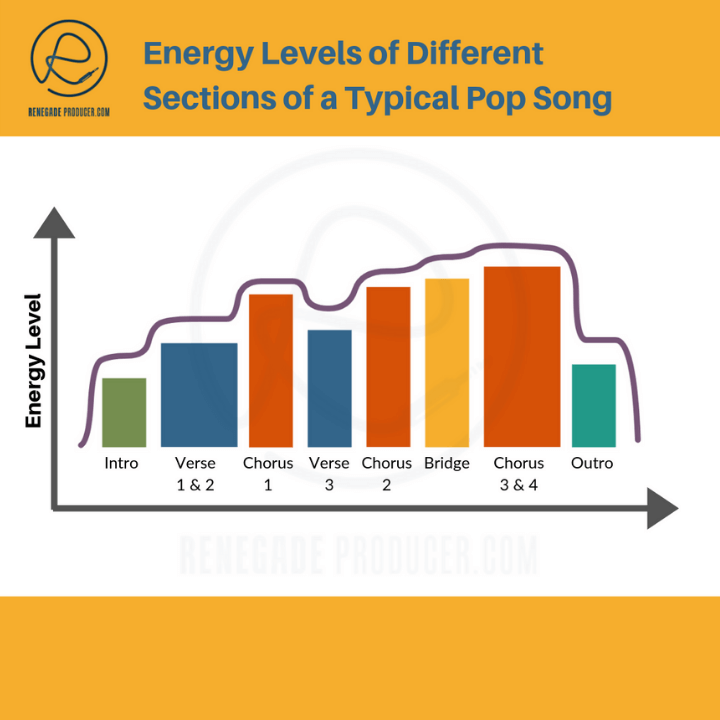25-step music production process checklist and video workshop >>>
Song Structure Basics for Music Producers + Pop Song Form Examples Infographic

Song Structure - What is it Good For?
It's obviously helpful to understand song structure if you're writing songs or producing music. Can you get away with knowing nothing about it and still produce music? Yes, of course.
You'll however still be using song structure even if you don't know you're doing it. That's because the structure of a song is the invisible frame upon which the song hangs. Every song has a structure.
So, as you can imagine, a bit of knowledge will speed up your writing and production workflow because you'll be aware of what works and what doesn't, and this will help you make decisions and implement them faster when you write or arrange your music.
In this post we take a look at some of the basics of song structures music producers need to learn about. It helps to know a bit of basic music theory vocab before you delve into song structures.
If you however already know your bars from your beats by now then jump right into it!...
Song Structure Terms:
The Basic Elements of a Pop or Rock Style Song
1. Intro
The intro of a song sets the stage for the rest of the song. The goal of the intro is to attract attention and introduce the listener to the song.
There are many different types of song intros but they'll usually contain less elements and energy than the chorus and in most cases the other parts of the song too.
A few types of intros you might come across:
- One example is a song that starts with the main chord progression without any drums or percussion.
- Another example is a song that does the opposite and starts with a drum loop or percussive intro.
- Yet another example may be a song that does neither and starts with something completely different to the rest of the song.
- There are songs that start with the chorus, often stripped down to allow for later contrast with the actual choruses.
There are no hard and fast rules for intros. It can be short or long. It can be a melody or a chord progression. It can be a drum part or a vocal. As long as it captures attention and introduces what's coming in the rest of the song it's all fair game.
2. Verse
The verse, in terms of lyrics, is where the journey begins. It's also where the story gets told and the tiny details, scenes and imagery is introduced to the listener.
Verses usually change every time they're repeated in a song. This change happens of course in the lyrical content but often also in the instrumentation with the addition or removal of certain instruments.
The verse will often stand both lyrically and musically in opposition to the chorus. It's at the same time what leads the listener to and prepares the them for the chorus. This relationship to the chorus is very important because the verse has to be different enough to the chorus to maintain interest while at the same time maintaining a musical relationship to the chorus.
The contrast between verse and chorus can be created by note choice. You could keep the verse on one note and introduce note intervals in the chorus. Or, vice versa, you could keep the chorus on one note and use scales or intervals more in your verse.
You could also use different timings in the verse and chorus. An example of this would be a song where the lyrics does straight-time in the verse and then double-time in the chorus.
3. Pre-Chorus
The pre-chorus, often nowadays called the lift, as the name suggests, sets the listener up for the chorus. It's used to create anticipation and give the chorus more impact when it does finally hit.
It creates a separation between verse and chorus and uses musical devices to prepare the listener for chorus.
Common practices include a change in the chord progression, the use of hooks and the stripping of all instruments except for one. This is often also a section in production where volume automation can be used to bring the level down by a small amount to accentuate the drop or chorus that follows.
4. Chorus
The chorus has to give your listener the main message or theme of the song. This part of the song will be repeated at least once and often doesn't vary too much from one instance to the next, as is the case with verses.
The chorus is the part of the song where people will tend to join in and sing along. It's often also the part that people remember after they've listened to the track.
The chorus, as mentioned above, stands in opposition to the verses. This doesn't mean that a chorus always has to be completely different to the verses, it still has to relate to them musically. Choruses often however need to give the listener the release to the tension created with the verses and pre-chorus.
It's not unusual for the songwriting process to start with a chorus as this is one of the most important aspects of the song.
5. Bridge
The bridge has the job of getting you from one section to another section of the song. Hence the name!
The bridge of a song is a musical or sonic variation that creates a contrast to the rest of the song. This contrast helps keep the listener engaged because there's something new to hook onto after they've gotten accustomed to the repeated verses and choruses. In popular music this is also sometimes known as the mid-eight section of a song.
The bridge is often right before the final chorus so it also has the function of preparing the visitor for the climax of the song.
5. Outro
The outro is where the song concludes. This may be similar to the intro in that elements could be stripped down to only a few. This part could be a definite musical conclusion or a repeat and fade-out type of outro.
In dance music styles the outro is often used to give DJs a chance to mix in the next track, so it may only be a simple kick with no melodic elements.
It can also be helpful in certain cases to think of the outro as the opposite of the intro. So if you're build up tension in the intro then the outro will be more about release.
Song Structure Chart: Common Song Structures & Terms

Common Song Structures or Forms:
In the song structure chart above you'll see a list of common song forms. Different sections are each labelled with a letter. In AAA form you'll only find one type of section, so the song will just be verses. ABA form will include a chorus section.
Different song forms can be combined to create compound song forms and as you can guess there are many variations.
It's a smart move to learn all you can about various song forms because it'll give you a toolkit to work with when you write or produce music.
I won't go to deep into the various forms here. The folks over at Songstuff.com have done an excellent write-up on song forms so rather than reinvent the wheel I suggest you check out their song form overview post here for to expand your knowledge of song forms and find examples of songs with the mentioned structures.
Song Structure and Energy Levels:
Music is about energy and emotion. So, when you think about song structures you need to think partly in terms of the energy levels involved in each section or part of your song.
The energy level cannot be the same all the time, as this would bore the listener to bits very fast. In most cases your choruses will be the sections with the most energy or intensity, with most of it in the final chorus or climax.
A good song structure allows your listener to go on a journey. Not too much too soon and also not too little to late.
It's about feeling so you'll use your ears, musical taste and discernment to make song structure choices.

Electronic or Dance Track Structure:
Electronic dance music has a different purpose than traditional pop or rock songs in that the main function is to make people dance and not just listen.
The basic structures may be the same but sections can be a bit longer as the tracks in general don't stick to the 3:30 min length of your typical pop tune. Dance tracks tend to clock in anywhere from 5:30 mins to over 7 mins in some genres.
Most sections have an even number of bars. So you may start with a 16 or 32 bar intro followed by a 16 bar breakdown followed by a 16 bar drop followed by a 16 bar breakdown followed by a 8 bar bridge and then a 16 or 32 bar drop and then a 16 bar outro.
Dance music song structure terms are a bit different than traditional pop or rock styles:
You'll still speak of intros, outros and bridges. Instead of verses and choruses however you'll often hear producers speak of breaks, drops and builds or rises. Let's take a look at these terms quickly...
1. Break or Breakdown
The breakdown section in electronic dance-style genres loosely relates to the verse. The break will in most cases be lower-energy than drops. A typical break could start with 8-16 bars of a simple beat and progression followed by 8-16 bars of a build or rise which is still part of the break. See below for more on builds.
2. Build or Rise
The build section has the job of heightening the suspense and setting the listener up for the drop that follows it.
There are various techniques available to help you create this mounting tension. Examples include snare rolls that speed up as you get closer to the drop and risers that increase in pitch.
3. Drop
The drop relates loosely to the chorus of a traditional pop song in that it carries the main message, theme or motif of the track. The drop is also, more often than not, the section that contains the most elements or highest amount of energy in your track.
Song Structure - What To Pay Attention To:
The role of a song structure, as mentioned before, is to lead your listener through the journey of the song. It's how you grab attention and keep it from first note to the final cymbal crash.
A song that repeats the same thing over and over the same way will quickly bore the listener. Skip! Ouch.
This is why you want to pay attention to things like:
- Variations - How do the same parts change as they repeat.
- Transitions & Fills - How do you move from one section to the next in a pleasant way.
- Tension & Release - How do you gradually create suspense and push a listener into the next section.
- Surprises - They think they know what's going to happen next. Surprise them by doing something else!
The best way to learn how to do this well is to learn to critically listen to professional released tracks and analyze them...
How to Do Basic Song Structure Analysis:
An excellent way to learn what works and what doesn't in terms of song structure is to do some basic analysis of already released songs.
There are many ways to analyze a song but in terms of structure the process pretty straightforward:
- Grab a pen and a large notepad.
- Listen through the song.
- Count the bars, section by section and make note of the section length in terms of bars.
- Next, pay attention to which sections are used when to extract the song structure. Note it down.
- Then, note the variations or differences between repeating verses. Do the same for choruses.
- Listen to pre-choruses, breaks and any other non-verse or non-chorus parts. Make notes.
You're goal here is to notice what happens where in the song and why it works or doesn't work to create the emotional effect wanted in the listener.
The aim of this is to get your ears and brain used to analyzing songs. The process also helps you learn about what works and what doesn't work and figure out why it works or doesn't. If you're good with music theory you can also analyze the chord progressions and melodies to better understand how they relate to the structure.
Creating a Song Structure - One Easy Little 4-Step Hack:
One great thing is that, last time I checked, you cannot copyright a song structure. Woo hoo! Now, this is of course not legal advice and don't quote me on that. ;-)
The above fact means that you can use other completed songs as a reference for your own arrangement and still sleep well at night. In fact, tons of songs, especially those in the same genre, often share the exact same arrangements.
Now, that song structure hack I promised...
- Find a song or track that matches the style and tempo of the track you're working on. Some sites like Beatport give the tempo of the track. Otherwise, do some googling for the tempo and failing that use the tap tempo in your DAW to tap in the tempo.
- Then, load the reference track into your DAW and make sure it lines up with your grid. It's easiest to line up the downbeats.
- Next, use your markers to color code and name the different sections of the track.
- Finally, delete the reference track and save your project. Boom!
You now have a skeleton or frame of reference to base your own song structure on. No mess, no fuss.
You can of course switch it up here and there and cut out, add or extend sections.
This little arrangement hack obviously speeds up your production workflow. It however also has the added bonus of being a great way to learn about different song structures as you can analyze the arrangements as you go.
Oh, and you'll be surprised how many top producers do exactly this. ;-)
Conclusion:
This little introduction to song structure basics will get you started.
Remember, there are no hard and fast rules with song structure, just certain time-tested forms that have been proven to work well over a long period.
Your best approach as a producer is to learn as much about the different song structures that are often used. Then, when you're familiar with the different types of structures you'll start to learn how to create your own arrangements in a way that makes sense for your music.
So, find some examples of the most common song forms and analyze them until you understand how they do what they do and the effect it creates in the song.
Next, analyze the tracks in the genre you want to produce in and make sure you get a basic feel for the most common structures used in your particular genre.
Then, pull some of your favorites into your DAW and produce some tracks around the song you've imported.
This practice will in time give you an intuitive feel for what works and what doesn't.
Oh, and always be analyzing more tracks when you get the chance. ;-)
Now go make some great music!
P.S. You can improve your arrangement and song structure skills straight away with this PML course...
The Arrangement Course over at Production Music Live (outside affiliate link) teaches you the core concepts and methods you need to move from loop to full arrangement with your tracks.
You can get it as a single course, part of the Harmony bundle or included in the All Courses bundle. This course is an ideal way to get you thinking about song structure and started with a firm foundation for your arrangement skill-stack. Get it here to support RenegadeProducer.com at no extra cost to yourself. Thank you!
Get More Skills for Your Producer Skill-Stack:


Learn to understand equalisers and frequencies to supercharge your mixing skills and get results, fast...

New producer? Learn everything you need to produce your first professional track right now...

Would you like to discover the simplest and easiest way to learn music theory as a music producer?
Share this post. Spread the knowledge so other producers can benefit too:
- Renegade Producer
- Producer Skills
- Song Structure
ⓘ Some pages contain affiliate links so I might earn a commission when you buy through my links. Thanks for your support! Learn more

